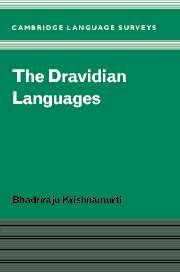Book contents
- Frontmatter
- Contents
- List of illustrations
- List of tables
- Preface
- Acknowledgements
- Note on transliteration and symbols
- List of abbreviations
- 1 Introduction
- 2 Phonology: descriptive
- 3 The writing systems of the major literary languages
- 4 Phonology: historical and comparative
- 5 Word formation: roots, stems, formatives, derivational suffixes and nominal compounds
- 6 Nominals: nouns, pronouns, numerals and time and place adverbs
- 7 The verb
- 8 Adjectives, adverbs and clitics
- 9 Syntax
- 10 Lexicon
- 11 Conclusion: a summary and overview
- Bibliography
- Index of reconstructions with glosses
- General index
11 - Conclusion: a summary and overview
Published online by Cambridge University Press: 22 September 2009
- Frontmatter
- Contents
- List of illustrations
- List of tables
- Preface
- Acknowledgements
- Note on transliteration and symbols
- List of abbreviations
- 1 Introduction
- 2 Phonology: descriptive
- 3 The writing systems of the major literary languages
- 4 Phonology: historical and comparative
- 5 Word formation: roots, stems, formatives, derivational suffixes and nominal compounds
- 6 Nominals: nouns, pronouns, numerals and time and place adverbs
- 7 The verb
- 8 Adjectives, adverbs and clitics
- 9 Syntax
- 10 Lexicon
- 11 Conclusion: a summary and overview
- Bibliography
- Index of reconstructions with glosses
- General index
Summary
Introduction
A summary of conclusions from different chapters, which throw light on the subgrouping of the Dravidian languages adopted here, will be presented with a short review of earlier work on this topic. I will briefly speculate on the probable date of Proto-Dravidian. I have left out several questions like the original home of the Dravidians and whether they were the same people who ruled the Indus valley around 2500 BCE. The Proto-Dravidian culture that I have reconstructed, based on comparative vocabulary in section 1.2.2, must help archaeologists and linguistic archaeologists to sort out this problem. I have hinted at the future direction for research in Dravidian studies, comparative and typological.
Earlier attempts at subgrouping the Dravidian languages
Serious attempts at the subgrouping of the Dravidian languages proceeded hand in hand with the study of a number of new languages, mainly in central India, namely Kolami, Parji, Naiki, Ollari, Gadaba, Koṇḍa, Pengo etc. during 1950–75. Earlier, L. V. Ramaswami Aiyar, E. H. Tuttle and T. Burrow (till 1950) placed Telugu in South Dravidian (our South Dravidian I). I have noted that Telugu is genetically closer to its northern neighbours, Gondi, Koṇḍa, Kui, Kuvi, to which Pengo and Manḍa were added later. Burrow and Bhattacharya (1953: xi) have pointed out the close relationship among Parji, Ollari, Gadaba, Kolami and Naiki. They also speak of ‘many signs of special connection between Gondi–Koṇḍa and Kui–Kuvi’.
- Type
- Chapter
- Information
- The Dravidian Languages , pp. 489 - 503Publisher: Cambridge University PressPrint publication year: 2003



